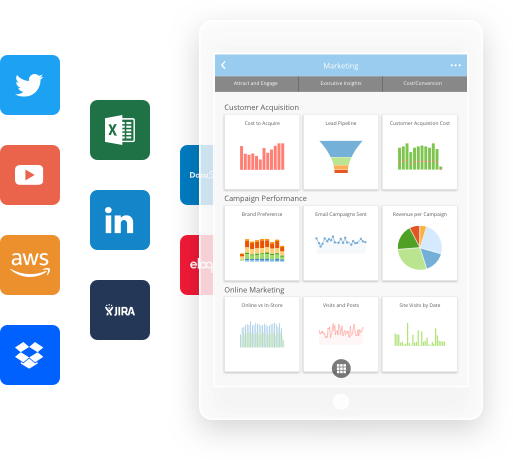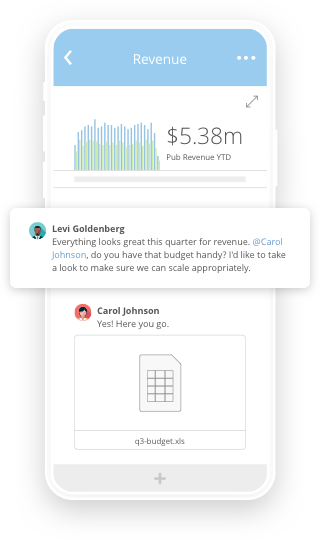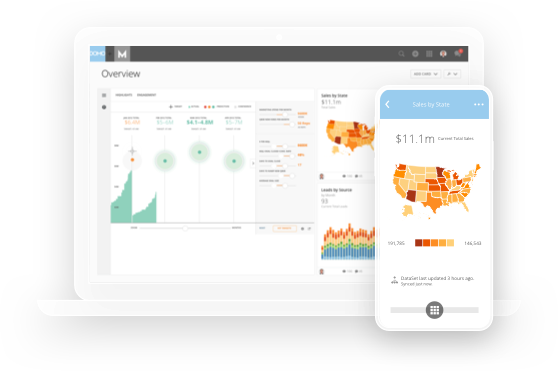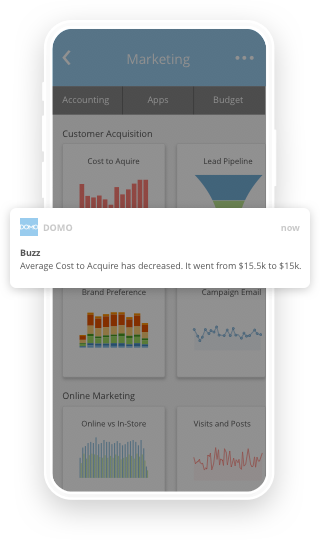Domo pricing is based on several factors. These include; data size, required update frequency, user counts, and customization requests. Domo is extremely adaptable, but that adaptability means it can be an ideal fit with a broad range of use cases. However, since each use case is unique, it's difficult to advertise rates for their software. Domo doesn't currently advertise pricing on their website. Each Domo project is scoped with an individual customer's requirements in mind. To learn more or to schedule a meeting with a member of Domo's sales team, click here.
More information on Domo's pricing:
Variable rates help businesses to save money, since they only need to pay at a level that's appropriate for them. If Domo were to offer a high flat rate, many businesses wouldn't be able to afford their tool, even though they didn't plan to use all of Domo's features. A flat rate means a business has to pay for features it might never use. With a variable rate, Domo can work with their customers to find the pricing solutions that best fit their customer's budget and use case.
Domo's pricing model also reflects their commitment to making data analytics accessible to everyone. By keeping their prices variable, Domo is opening up their tool to more businesses who want to take advantage of data-driven insights.
In general, variable pricing helps businesses get the product they need at the price that makes the most sense. Larger businesses can pay more for added expertise during the implementation process and for added tech support after the fact, and smaller businesses don't need to pay more than they have to to get access to Domo's powerful analytics suite.
The price of a specific Domo implementation varies, but there are a few factors that Domo uses to establish a price.
Domo bases their price on the complexity of the planned use case and the scale of the planned implementation. While pricing can depend on many other factors, smaller businesses can typically expect to pay less than larger ones (depending on variables). Those using Domo for complex jobs will likely need more support, which can drive up the price. Less complicated implementations will cost less.
For example, a large, national corporation might work with Domo to provide analytics for their entire company. This is a massive, complex implementation, and that business will need a lot of help from Domo to make sure it goes smoothly. A smaller business intelligence tool that advertises a flat rate for their services couldn't justify helping their customer with this implementation, since their rate only covers a small part of this cost. With a variable rate, Domo can ensure that their costs are covered, and provide more expertise in the implementation process. These sorts of enterprise-scale implementations can only work if Domo charges a variable rate.
Smaller companies don't need as much help with implementation. Since Domo doesn't need to cover costs for these smaller accounts, they can charge a smaller fee than they would have to otherwise. In a flat-rate model, those costs are baked into the monthly fee, whether or not a business actually makes use of them.
In many cases, Domo charges per seat; this means that they charge businesses for each separate set of login credentials. Businesses can pay to add additional users as they grow. A smaller business won't need very many sets of login credentials, which helps to keep the price manageable. Larger businesses need data insight at many different points in their process, and so can pay additional fees to bring Domo to more people and teams in their organization. Again, this helps to ensure that businesses pay the costs that make the most sense for their situation. If a business decides they need more seats after the fact, it's relatively easy to buy more credentials.
Per-seat pricing also allows businesses to only pay for the access they need. Most employees don't need access to Domo's full feature suite; they may only need to do some small analytical work or build simple dashboards. Others don't even need that functionality; they just need to be able to see the dashboards and visualizations that others have already made. Per-seat, variable pricing means that businesses can pay different rates for different employees; they don't need to pay for the full Domo experience for the whole team. At many organizations, only a few senior employees have full Domo credentials bought for full price; all other employees have discounted accounts.
Domo charges additional fees for data storage and for increased data refresh speeds. The more data a business intends to store in and funnel through Domo, the more they will have to pay. While it can be easy to think that Domo and other business intelligence companies have infinite storage space, they still need to put data somewhere. In the same way that businesses had to store all of their data on internal servers before cloud-based solutions existed, cloud-based solutions have to store all their data on on-premise server farms. That storage space isn't infinite, and businesses that use large parts of it will need to pay more than businesses that don't need as much.
Again, this helps Domo align their price with the financial needs of their customers. Large businesses need an economical solution for storing and processing all their data. Domo is happy to be that solution. Smaller businesses don't have as much data, and don't need the same storage solutions. Domo doesn't charge these businesses for storage and computing power they'll never use.
Domo offers a fully-featured free trial, which lasts for 30 days. They also offer free demos of the software so that businesses can get a feel for the software before they buy.
In general, Domo's pricing structure allows businesses to find the pricing model that works best for their situation and use case. Large businesses and enterprises can pay more for additional expertise and attention, while small businesses and startups can get their business intelligence solution for a lower cost. Domo works with their customers so that pricing is flexible, instead of a one-size-fits-all solution that leaves many out.
 Users especially like Domo’s customer service.
Users especially like Domo’s customer service. Several users mentioned how simple Domo is to use and is excellent for data flows.
Several users mentioned how simple Domo is to use and is excellent for data flows. Users like how easy it is to share information to other users.
Users like how easy it is to share information to other users. A few users want read-only shareable PDFs.
A few users want read-only shareable PDFs. Users want more training documentation.
Users want more training documentation.








